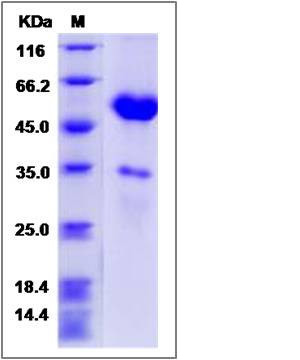Cynomolgus OX-40L / TNFSF4 Protein (Fc Tag)
TNFSF4
- 100ug (NPP1677) Please inquiry
| Catalog Number | P90088-C04H |
|---|---|
| Organism Species | Cynomolgus |
| Host | Human Cells |
| Synonyms | TNFSF4 |
| Molecular Weight | The recombinant cynomolgus TNFSF4 is a disulfide-linked homodimer. The reduced monomer comprises 369 amino acids and has a calculated molecular mass of 42 KDa.The apparent molecular mass of it is approximately 48 KDa respectively in SDS-PAGE. |
| predicted N | Asp |
| SDS-PAGE |  |
| Purity | > 85 % as determined by SDS-PAGE |
| Protein Construction | A DNA sequence encoding the cynomolgus TNFSF4 (F7FL80) (Gln51-Leu183) was expressed with the Fc region of mouse IgG1 at the N-terminus. |
| Bio-activity | Immobilized Cynomolgus mFc-TNFSF4 at 10 μg/ml (100 μl/well) can bind human TNFRSF4-Fch (P10481-H03H), The EC50 of human TNFRSF4-Fch (P10481-H03H) is 0.23-0.55 μg/ml. |
| Research Area | Signaling |Signal Transduction |Other Related Intracellular Topics |Cellular Senescence and Pathways in Aging |Apoptosis |Extracellular Signals | |
| Formulation | Lyophilized from sterile PBS, pH 7.4. 1. Normally 5 % - 8 % trehalose and mannitol are added as protectants before lyophilization. Specific concentrations are included in the hardcopy of COA. |
| Background | OX-40L, also known as TNFSF4 and CD252, is a cytokine that belongs to the tumor necrosis factor (TNF) ligand family. OX-40L is an important costimulatory molecule that plays a crucial role in the regulation of T-cell-mediated immunity. The interaction of TNFSF4-TNFSF4 is involved in the pathogenesis of multiple autoimmune and inflammatory diseases such as systemic lupus erythematosus (SLE), carotid artery disease and cancer. OX-40L is a ligand for receptor TNFRSF4/OX4. It is found to play a role in T cell antigen-presenting cell (APC) interactions. In surface Ig- and CD40-stimulated B cells, this cytokine along with CD70 has been shown to provide CD28-independent costimulatory signals to T cells. This protein and its receptor are reported to directly mediate adhesion of activated T cells to vascular endothelial cells. |
| Reference |
